Table of contents
You’ve spent valuable time and resources optimizing important pages on your website.
Now, how are you reporting on the impact of your efforts? After all, if you don’t know whether your on-page changes have worked, how can you continue to grow traffic to that page?
Good SEO reporting can be just as impactful as the changes themselves.
But reporting isn’t an easy thing; you need to make sure the metrics you’re including in your SEO dashboard are actually valuable. Otherwise, you’ll just show a bunch of KPIs that don’t really mean anything.
We wanted to find out how people do this. So, we asked 50+ experts.
Here are 27 metrics and tips that will help you create an awesome on-page SEO report:
- Bounce rate
- Backlinks
- Click-through rate
- Conversion rate
- Crawlable and indexable content
- Dwell time
- External links in site content
- Event completions
- Exit pages for organic traffic
- First contentful paint
- Keyword rankings
- Keyword usage
- Keyword clicks
- Internal links
- New users
- Mobile traffic
- Month-on-month growth
- Organic traffic
- Revenue per visit
- Page URL
- Page speed
- Schema details
- Share of voice
- Time on page
- Top organic landing pages
- Timeline of on-page SEO changes
- Use these metrics together, not in isolation
1. Bounce Rate
Iron Monk‘s Jack Choros advises tracking this in your on-page SEO report because “it represents the percentage of users that leave your website after landing on only one page.”
“Usually you only get one or two clicks to get a user’s attention in order to get them onto your website. If they instantly leave it tells you that your landing page or homepage isn’t compelling enough.”
“The last thing you want is to spend money on ads and search engine optimization only to find out that most of the people that actually follow through on searching for you are clicking through on ads are going to leave anyway.
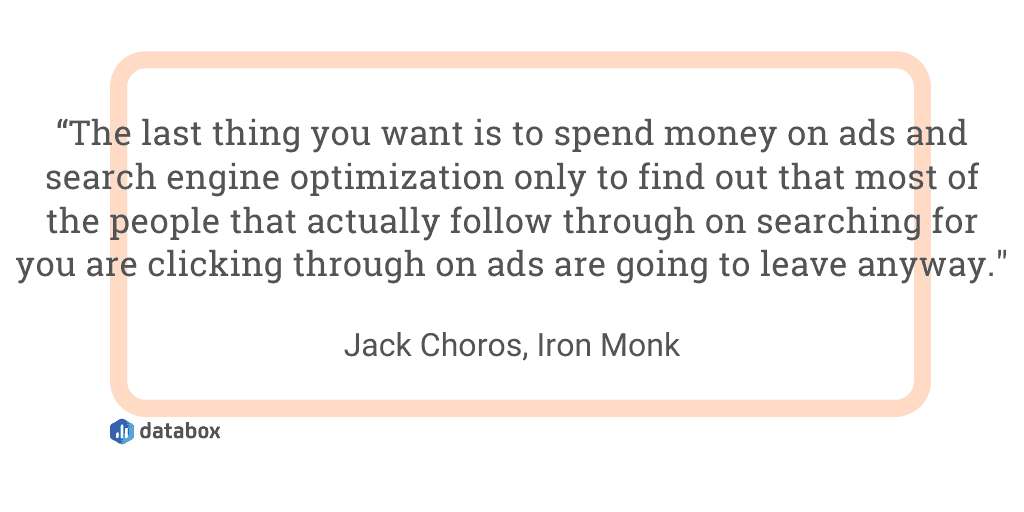
Daniel Torres Pacheco also says they track this at Zety “because we create a plethora of landings pages, and continually monitoring the bounce rate helps us contrast, compare, and analyze why some pages perform better than others.”
Toni JV of JVT Media adds: “Satisfying user intent is the #1 goal with SEO, without it, nothing else works. So when you work to improve things like bounce rate, you automatically increase your performance.)
2. Backlinks
Backlinks are the bread and butter of any SEO report.
Mailbird‘s Andrea Loubier explains why: “If you’re trying to help your site move up on Google’s rankings, then having links on other sites is one of the ways you can achieve that. This can be done through many different methods, including guest posts, links to your content, and providing quotes to writers.”
WILD‘s Romain Chiaramonte adds: “Most of the time, SEO expert only mentions global referring domains whereas it includes No Follow = no juice. So, by transparency, you should mention only Do-Follow referring domains (even if No-Follow link will be crawled starting March 1st.)”
3. Click-Through Rate (CTR)
“Although there are a lot of important on-page metrics, the CTR is something that I always look out for,” says Adam Lumb.
“It gives you an immediate indication about which articles are driving traffic to your site, although you should always take into account the number of Impressions each article is getting, along with how competitive the keywords are for a wider perspective.”
“However, CTR is a great starting point as you’re able to quickly see which pages are doing well and which are underperforming. For those that need tweaking, it’s usually a quick fix with changes to the meta title and description being easy to implement, while also often impacting upon CTR heavily.”
Stephen Fischer of Weidert Group explains: “Reporting on CTR will tell you if 1) you’re reaching page 1 of the SERPs (in order to get clicks); 2) you have a compelling meta description & page title to grab the user’s attention.”
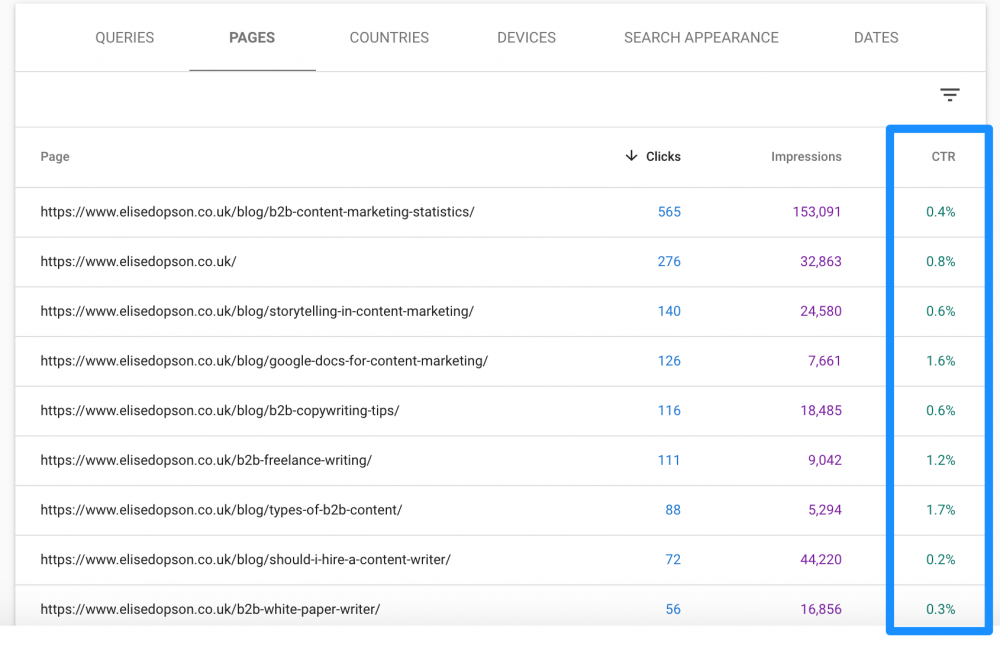
Plus, Venngage‘s Aditya Sheth says: “Think about this: if you improve your CTR from 1% to 5% for just a single blog post (on Google SERPs) that’s 5x more traffic landing on your site which automatically boosts your other on-page metrics. By a lot. CTR is the perfect example of a metric that influences other metrics.”
This metric is so important that Linda S. Davis of 500WordEssay advises to break this down into two categories:
- “CTR per landing page: Examining the CTR of landing pages will show the pages that have the most attention in the search engine. It is also a good way to find pages with lower performance and optimize them.
- CTR by keywords: If a term is found that is receiving a large percentage of clicks, it is necessary to find out which pages are generating this traffic and verify that the content is accurate and concise with the searched terms.”
In fact, Paxful‘s Jeffrey Barroga “believe[s] it’s the most crucial metric after website traffic and keyword rankings as CTR is the best indicator of how well your page matches the searcher’s intent. Your page might reach the top position in SERPs but it wouldn’t matter if the title tag and meta description fails to resonate with users and entice them to click.”
Summarizing, Grooming HUT‘s Frederik Hermman says: “Rankings are great but if no one is actually clicking to come to your site then you will have to re-evaluate your titles and descriptions.”
4. Conversion Rate
“Generating tons of traffic is great, but how well this traffic converts on your website is what matters at the end of the day,” says Glassdoor‘s Ophélie Marten-Jeanroy.
Joseph Lopez of PROSTEP INC explains: “All techniques for on-page SEO optimization play a vital role in obtaining conversion rate goals. Creating high-quality content, optimizing headings, page speed, image, and code optimization are important for on-page SEO, but that doesn’t mean anything if the page isn’t generating conversions.
“In my experience, I’ve been able to rank #1 for niche keywords. The excitement becomes puzzling analyzing the amount of organic traffic and low-conversion rate %. Therefore I look at organic conversion rate every time an on-page SEO report is generated.”
However, Chris Hustad of Flyway Media argues that “this depends on the customer. If they’re engaging in e-commerce, then it’s very important to track the sales conversion rate, as well as time spent on the site as well as the bounce rate.”
“If it’s a service industry, then tracking user behavior is important. Are they finding the contact page? Are they reaching out?”
“At the end of the day, this is what matters. If users are struggling to find how to contact or get a quote, they’re going to move on to a competitor who has this all presented,” Hustard adds.
Michael Keenan summarizes: “It’s less important how much traffic organic brings in, or what keywords you rank for. If you can’t get someone to join an email, start a free trial, or download a piece of content — you’ve got a bigger problem on your hands.”
Related: Content Marketing ROI: 13 Lead Generation Metrics to Measure & Report Every Month
5. Crawlable and Indexable Content
According to ResumeLab‘s Agata Gruszka, “you need to make sure your content is indexable and the main content is the same with or without JavaScript crawl. If your content is not visible to search engines then all optimization is worthless.”
“Checking the indexed pages and testing them with fetch as Google tool.”

Gruszka adds: “Compare them with and without Javascript (you can use a small script as a bookmark which will give you the side by side comparison).”
6. Dwell Time
“Dwell time is a simple metric that’s not tracked by a lot of companies,” Eric Mellmer of Proline Range Hoods explains. “It is the amount of time that a consumer spends on your site after clicking the Google result or link to your content.”
“The longer someone stays on your site, the more likely it is that they found the information they were looking for.”
“Images, videos, and interactive media are all effective ways to increase your dwell time. Assuming the content is relevant, longer articles will keep your audience engaged for a longer period of time,” Mellmer adds.
7. External Links in Site Content
“Outbound links are often overlooked when it comes to SEO, but they can be just as important for ranking higher in the SERPS as backlinks are,” says Best Company‘s McCall Robison.
“Reboot Online actually completed an experiment and tested if placing external links in site content would help a website improve in the SERPs. To test this, they created 10 new websites, half of them included external links (linking to authority sites) and half didn’t. The websites with external links ranked higher than the websites that did not include any external links.”
Robison continues: “Because content and SEO teams are often so focused on building backlinks, they are neglecting to place high-quality external links in their content.”
“External links to authority sites are what tells Google that you have quality information on your website and that you have referenced other authority sites in your content. Referencing and linking to authority websites in your content not only creates a better user experience, but it also gives you a great deal of SEO value.”
“My team has focused so heavily on backlinks that we were neglecting to see how important external links are. We were including them, but we weren’t being as determined or as careful as we should’ve been,” Robison adds.
“Because of this, we made the number of external links we add to our content a big part of our on-page SEO report. Since doing so, our content has gotten better because we are referencing more authority sites, and our rankings have gotten better because Google is seeing us as more of a trusted resource.”
PRO TIP: How to Monitor and Evaluate Your SEO Performance
If you want to understand how your visitors are behaving on your landing pages, there are several on-page events and metrics you can track from Google Analytics 4 and Google Search Console that will help:
- Organic clicks by queries. Which search queries generate the most clicks to your website?
- Organic clicks by page. Which pages receive the most clicks from search results pages?
- Organic sessions. How many organic search sessions does your website receive?
- Organic engaged sessions. How many website visitors were engaged with your content? An engaged session lasts longer than 10 seconds, has a conversion event, or has at least 2 pageviews or screenviews.
- Views per channel. Which channels generate the most views to your website?
And more…
Now you can benefit from the experience of our SEO and website conversion experts, who have put together a plug-and-play Databox template showing the most important metrics for monitoring your landing page performance. It’s simple to implement and start using as a standalone dashboard or in marketing reports!
You can easily set it up in just a few clicks – no coding required.
To set up the dashboard, follow these 3 simple steps:
Step 1: Get the template
Step 2: Connect your Google Analytics 4 and Google Search Console accounts with Databox.
Step 3: Watch your dashboard populate in seconds.
8. Event Completions
“I would say one of the most important metrics to include your on-page report would be individual event completions from Google Analytics,” writes Mason Stout of Senior Leaf. “Custom events will be the best metric that gives a monetary value for your business.”
“Getting traffic to your page is great, but it doesn’t mean a lot if that traffic isn’t converting. You can tag a form completion or a click to call button, or any other item on your site. Once you know how many custom events your organic traffic yields, you’ll have an actual ROI for your SEO efforts.”
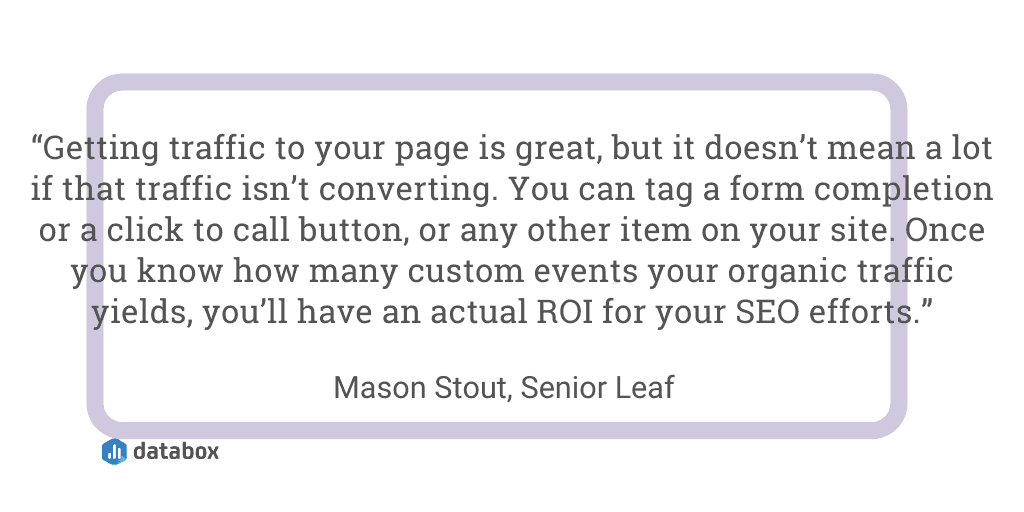
Related: 25 Tips for Properly Setting Up Google Analytics On Your Website
9. Exit Pages for Organic Traffic
“For anyone that doesn’t know, exit pages are the last pages that people visit before they leave your site,” Ellie-Paige Moore of the bolt way explains.
‘It’s so important that you keep track of the top exit pages. I always class these as the pain points of any site, as these are the pages that cause people to lose interest in your site and go elsewhere.”
Moore continues: “If you’ve made on-page SEO improvements, you would hope to see the exit page percentage decrease as that would mean the amendments or improvements you’ve made to that page have made an impact on this metric.”
10. First Contentful Paint
“The one metric I always have in every SEO report is “First contentful paint” from the PageSpeed Insights analysis,” William Chin-Fook of MyWifeQuitherJob.com explains.
“I will also add in the page speed of the top 50 pages so that we can really get a better macro picture of the site. Over a period of a month (the frequency on when I send of SEO reports), there can be a number of changes done to a website (by their development team) as well as changes in Lighthouse’s auditing criteria.”
“Therefore, it serves two purposes: One – a gut check to ensure that the website’s top pages are still performing up to Google’s standards, and Two – allows me to showcase to the client that their site is not loading slow.”

11. Keyword Rankings
“Your keyword should be in your title tag, heading tags, your actual content, your meta descriptions; the list goes on,” says Blueclaw‘s Kyle Moody. “So, for an on-page SEO report, it only makes sense that you need to include the positions of said keywords in search engine results pages.”
“The best way to show this is in a table comparing month-on-month or year-on-year data, depending on what you have access to and which period you choose to track over (there are pros and cons to both). If we take month-on-month as an example, your table should show.”
Jamie-Lee Kay of The Other Straw adds: “This is really important as it will help you allocate your time and resources to certain keywords that are not performing well and understand why some keywords are performing well.”
This is why Dale Johnson of Nomad Paradise recommends to include the “number of position 1-10 ranking keywords.”
“Having 20k ranking keywords looks great, but the fact of the matter is, ranking 11th is practically the same as ranking 111th. You’re top 10, and even more-so top 5, are the pages that will bring you the largest % of traffic by a long way.”
Plus Khris Steven of Khrisdigital argues that “this metric helps to indicate whether your overall SEO strategy is working or not. And tells if you should try something else. It’s from this metric we can all tell the type of contents and keywords to target and how we should optimize each and every one of our posts for rankings.”
Summarizing, Deepak Shukla of Pearl Lemon adds: “Paying attention to how rankings are changing and how quickly can help you forecast results and determine what your focuses should be.”
Editor’s note: Are you constantly sharing links to multiple tools or reports for people in order for them to get a full view of how things are going? With Databox, you can stream dashboards of important metrics from any department to your TV and have all data accessible in one place, on demand.
Related: The 23 Best Keyword Tracking Tools (According to 107 SEOs)
12. Keyword Usage
It’s not just the keywords you’re ranking for (and the positions of them) that you should include in an on-page SEO report.
Igor Buyseech of SEOPRO s.p. thinks: “The most important aspect of on-page is, unfortunately, the most misused and ignored part, as per our research and findings in the field. I have checked thousands of websites on-page in over a decade of working on SEO and even though everyone and their dog is saying that keyword in meta title, URL, and the H1 tag is a must, people continue to go against the grain.”
“If your website is about »CBD oil«, by all means, have »CBD OIL« in the top3 mentioned places 1x (and only 1x). Why would a site about »CBD oil« be called »Products« or »Home«. This might seem absurd to some, but it’s the case in at least 30% of the sites we have worked on.”
Buyseech continues: “The biggest gains in ranking come from the main keyword you are going after to be included in the top3 (at least 2, if the URL is already set in stone and you don`t wish to change it). Extra boosts will be given if the keyword itself is the first actual phrase/word of the title.”
“So »CBD OIL 5% – Brand name« is better and will rank better than »Products – Our oils – CBD OIL 5%« etc. This has been proven with countless tests in single variable testing environments as well as in the field testing.”
13. Keyword Clicks
“Keyword clicks are useful for a variety of tasks related to on-page optimization,” says Portent‘s Evan Hall. “Knowing where our clicks come from is going to give us a better idea of which keywords to prioritize than search volume.”
“When building a keyword list to use for rank tracking, Search Console is my first stop. Often a long-tail keyword with significant clicks will show zero search volume in keyword tools. If I build a rank tracking list based solely on search volume, I might miss these gems that are already generating traffic.”
Hall adds: “Keyword clicks are also going to tell us which wording users prefer. If users are using a different phrase or synonym to reach our pages than the words in our title tag or H1, then we might need to change those elements to reduce friction for search users.”
“I also look at brand keyword clicks for my pages. If users are using a brand term to reach our page specifically, such as naming the product or article, then it’s a pretty good hint that page is important to other users. From there, I’ll check to see if the page might belong in the header or footer navigations, or might need a more prominent position in the content hub it belongs to.”
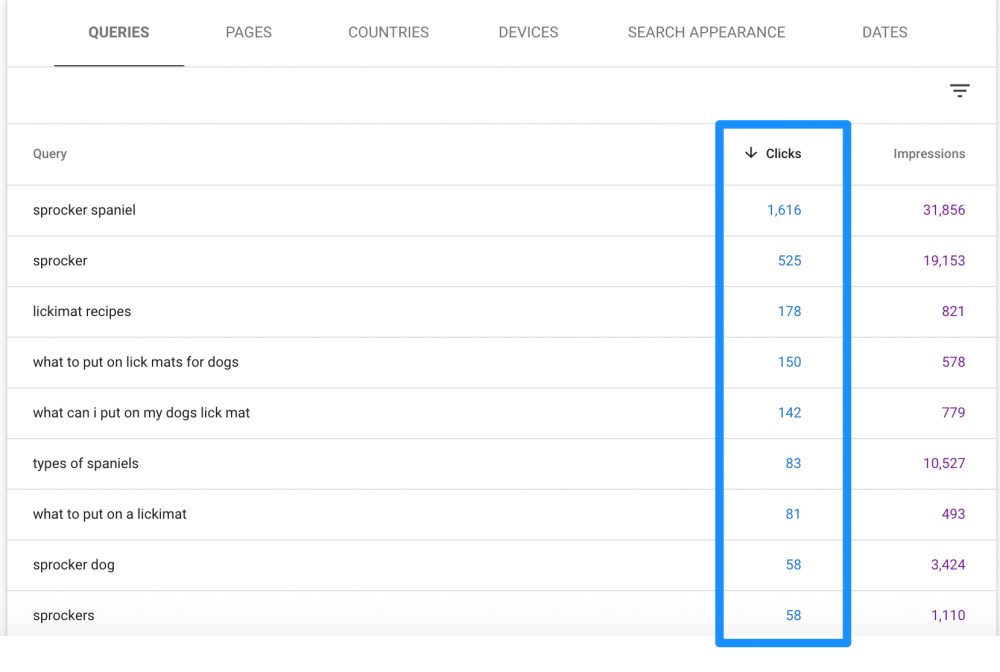
Colin Mosier of JSL Marketing & Web Design also says: “It is important to track your page visits from different keywords/phrases because then you are able to see where your main traffic comes from.”
“If traffic is coming from a particular word or phrase, you can optimize your website further to encourage additional traffic. If traffic is lower for a particular word, this can show you areas of improvement or even areas that you may not want to focus on as heavily in the future.”
14. Internal Links
According to Wolfate‘s Carlos Castro, “internal linking is a great underrated practice in On-Page SEO, it is a great way to pass page authority to new pages on your website.”
“Identifying the internal links of a page will help to understand the importance of that page within your website and may be used as a metric to prioritize optimization activities (such as link building) on internal pages.”
regpaq‘s Reggie Paquette also adds: “My favorite thing to look at in an on-page SEO report is each page’s “unique inlinks” from a page crawl.”
“Unique inlinks is the total number of unique pages on a domain that are linking to a page. Internal linking is one of the most important on-page SEO factors and I use this number to ensure each page is getting enough internal links that it needs to rank for its target keyword.”
However, Jamil Ali Ahmed of Cloudways says: “Internal linking is often neglected or it’s done incorrectly. Be wise about the anchor texts you use. Search engines divide the link value between all links on a web page.”
“This metric should be included in every on-page SEO report. You can track the performance of your interlinked content links by adding UTM links.”
15. New Users
Outlier Creative‘s Jenna Alburger thinks that “every on-page SEO report should use “new users” as a key performance indicator.”
“Just looking at pageviews and sessions does not provide insight into how much potential new business you are attracting through your site.”

16. Mobile Traffic
“Desktop traffic and usage keep falling as users in different niches prefer using phones rather than desktops as the main platform and the number of them has increased up to 65-78% already,” says Jennifer Broflowski of CraftResumes. “And this amount, as we expect, is to continue growing.”
“So, with the creation of the Starlink, a growing number of different mobile devices and companies that produce them, upcoming adoption of 5G technologies will altogether increase the amount of mobile traffic and its effects on SEO.”
Similarly, Beekeeper‘s Andrea Zamolo says: “Since so many people are conducting their online searches via their smartphones these days, it’s important to keep track of mobile metrics and to make sure that your site is as mobile-friendly as possible.”
17. Month-over-Month Growth
“When it comes to on-page optimization, you should be able to clearly tell the exact effects your work had on rankings, impressions, and CTR,” says SIM Tourist‘s George Mouratidis.
“It is important to mark the date, wait for Google to index the changes (reindexing your URL through Google Search Console helps), and then track changes on a month over month span. The improvement (or lack thereof) of the number of keywords, CTR, and the number of impressions you will get is a good indicator of your on-page strategy’s effectiveness.”
WOW Club‘s Sumitra Senapaty agrees: “While it’s important to check your numbers for the current month, the only way you can see if your strategies are causing improvement is by comparing them to previous months.”
“Plus, you’ll know when you need to keep with a particular method and when you should pivot and move on.
18. Organic Traffic
“Organic traffic is the number of people going to your website by way of searching on Google,” GeekWithLaptop‘s Anh Trinh explains.
“Your organic traffic data tells you how visible your website is through a Google search. Knowing this can help you make adjustments in bringing more traffic to your website.”
Irena Zobniów from Insightland adds that you should also track “organic traffic volume in correlation with seasonal trends.”
“Thanks to it, we can measure whether SEO activities bring measurable results from a business point of view and whether activities aimed at building organic visibility translate into valuable website visits.”
19. Revenue per Visit
“In my view, this is the single most important metric for a website: how much value are you driving from each visit to your website?” says Chris Moffatt of Kent Express.
“This metric is a reflection of the relevancy of your acquisition activity, as well as showing how effectively you’re converting that traffic into sales. For non-ecommerce websites, a revenue figure should be attached to a lead, allowing you to quantify the value of each visit.
20. Page URL
According to Jeremie Carroll of Smart Exposure Marketing, “the first and most important factor for SEO–on-page or off–is the URL. It is the first thing that Google reads to determine the relevance for a given page to the requested keyword.”
“There are obviously other factors like H-tags, content, keyword percentage in the content, and other factors, but the URL is the most important.”
“I have seen pages that by all accounts should have been ranking in the top 3 positions for a keyword that just weren’t getting there. Even with an extensive backlink strategy, they weren’t moving. Once we changed the page URL, the page would rank within days… or at the very least make a dramatic jump.”
“If there is a hierarchy to what Google looks at and gives weight to… URL is top on the list. This is why randomly populated or encoded URL extensions are very difficult to rank,” Carroll says.
21. Page Speed
“As the world goes more mobile-friendly, look to be so yourself,” Joe Babi of Joseph Paul Digital Agency advises.
“The majority of websites on the web today do a good job of making sure their site is responsive but site speed gets neglected which makes for frustrating load times for people not on WiFi (and Googlebots).”
Find your page speed using Google PageSpeed Insights:
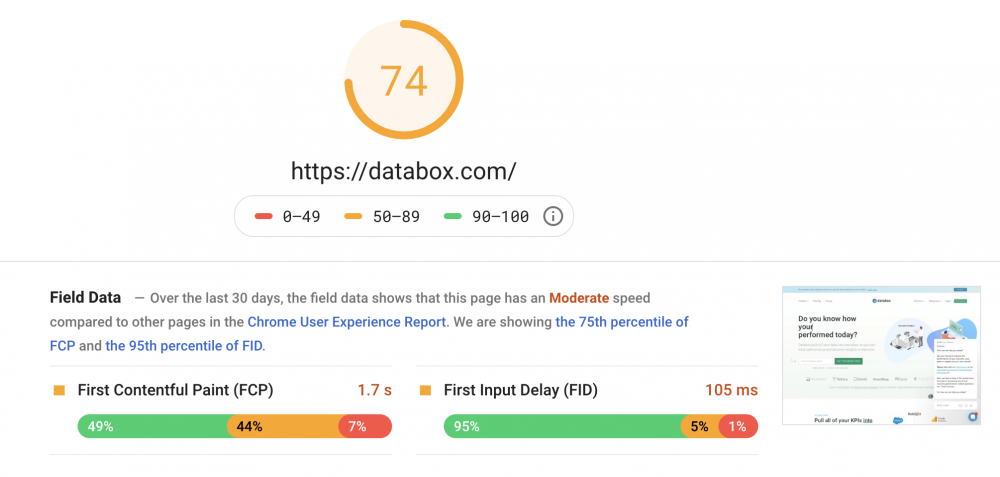
Clixsy‘s Allen Levings agrees: “While every industry is different, one thing Google (and users) expects from EVERY site is a fast loading page. Some niches may require more images than words, some niches may require more content than others, and so on but every site should load quickly.”
“Clunky sites with images that are too large, too many different fonts, uncombined CSS and non-CDN sites are going to struggle to consistently rank well for competitive keywords,” Shane Hampson of Blue Fusion Digital adds.
Alistair Dodds of Ever Increasing Circles also says: “Individual pages can be greatly affected by simple mistakes like uploading an image or graphic that has not been resized and compressed. As such it’s essential to always keep a close monitor on the situation month to month to ensure no standards slip.
Caleb Bailey explains: “The average load time for a website should be three seconds or less. Various tools from Google Search Console or Google Analytics can expose these issues in the early stages of a website. Hiring a qualified front-end developer is also a helpful solution.”
Alex Jones of Procedure Rates also recommends the Lighthouse Speed Score because it “produces actionable insights on how to improve speed if necessary. It’s useful to include this in the report as well, but don’t simply copy/paste the cookie-cutter output.”
“Go one step further and provide unique, custom-tailored analysis on how the specific page can fix the issue reported.”
22. Schema Details
“Schema can provide search engines with a better idea of what a page/website is about and removes the ambiguity,” Brian Barwig of Integrate Digital Marketing explains.
“If you have schema implemented on a page, the chances the page will have rich snippets increases dramatically. Who doesn’t want to earn more space in the SERPs?”
“Though not a ranking factor, that we know of, Schema can help make your listing stand out in the SERPs, improve click-through rate, and provide a better user experience for your website readers.”
Related: The Best Structured Data Tools for SEOs and Content Marketers
23. Share of Voice
This is typically used as a brand awareness KPI.
But Quattro‘s Sean Kainec explains how it can be used for SEO: “Share of voice is a calculated metric of where you rank and how much the search term is searched for a given period.”
“It literally tells you and the company how much exposure you can expect for your business at any moment so you know your audience size and can adjust strategies accordingly.”
24. Time on Page
“The problem is that quality content is very subjective,” says Digital Growth Genius‘ David Katic. “To try to remove this subjectivity I find that time on page is a really good indicator of how good a piece of content is. If a website visitor is spending a lot of time on a page it probably means it’s a good piece of content that is engaging the reader.”
“There isn’t a hard and fast rule for how long the time on page needs to be but I compare the time on page to other pages on a website. If it’s lower than similar content on a website then you need to reassess the content and work out how to improve it.”
Matt Cayless of Bubblegum Search adds: “Typically the longer a visitor spends on a page the better and indicates that the content is useful and answering the intent of their needs or the search query.”
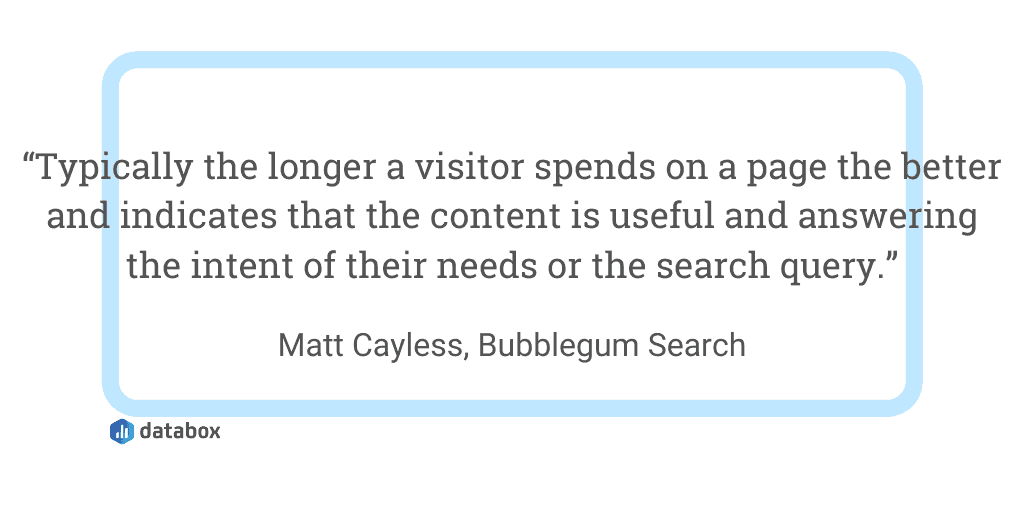
Kiwi Creative‘s Gwyn Wood explains: “For example, if you have a 2,500+ word pillar page that would take ten or more minutes to read, having an average time on page of two minutes would be an issue.”
“This works on the flipside too. If you have a short page with multiple opportunities for conversion and clock an average time on page of four minutes, then your users may not be compelled to go any further.”
However, Gary Hyman argues that “the time needs to be measured relative to itself. Google more than likely uses this data point to rank page positioning on SERPs.”
Futurety‘s Dinah Adams summarizes: “By identifying how long users are engaging with a particular page, you can make strategic decisions about how to expand or reduce content, introduce new calls to action, or even modify keywords.”
25. Top Organically-Searched Landing Pages
Tanielle Pereira of Check-in-London recommends tracking this metric in your on-page SEO report “because this is the main indicator of how the content of your website is performing from an organic SEO traffic perspective.”
“You can then dig deeper to see what keywords are driving traffic to these webpages and you can identify and improve on those webpages that have higher exit rates and if you have set up your goals correctly, you should be able to see the content that is performing best in line with your business goals (inquiries, bookings, downloads, etc.)”
26. Timeline of On-Page SEO Changes
“The only constant in SEO is change and with the flurry of algorithm updates, it can be difficult to decide if a change in ranking was caused by something you did or not,” says Andre Guelmann of SEO without BS.
(It’s true: Google changes their algorithm several times a year.)
Guelmann adds: “By tracking the exact dates of any change made to your metadata, you can overlay and compare them with known algorithm updates to determine how efficient your changes were.”
27. Don’t Look at Any On-Page SEO Metric in Isolation
“Multiple metrics are needed in order to stitch together a more complete story,” says Annalisa Hilliard of Data Dames Marketing.
“When we get stuck on one specific metric, it can become the focus of marketing strategy to the detriment of not only other marketing initiatives but also of moving the business toward its overarching goals and objectives. Instead, we begin to make trade-offs just to improve that one metric.”
Hilliard summarizes: “Always start with goals and objectives and determine which group of metrics to visualize and track with an SEO dashboard software in order to learn whether or not we’re making progress toward what we really want to accomplish.”
Final Thoughts
Don’t let your hard work go to waste once you’ve made a bunch of on-page SEO changes.
With these metrics, you can build a dashboard that shows the impact of your changes–which, hopefully, will help SEO become a huge driver of traffic (and revenue) for your business.















